Papers by Rosario Pineda Lopez
The Coleopterists Bulletin, 2017
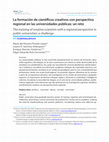
Diálogos sobre educación, 2019
Las universidades públicas se han convertido paulatinamente en centros de formación, desarrollo c... more Las universidades públicas se han convertido paulatinamente en centros de formación, desarrollo cognitivo y tecnológico, en las que se promueve una ciencia un tanto desvinculada de la sociedad y sus problemáticas. Así, surge una necesidad de construir plataformas interdisciplinarias y sistémicas. Considerar en la formación académica enfoques de creatividad colectiva y con perspectiva humanista, resultaría en un cambio de paradigmas ante la crisis socioambiental que enfrentamos, desde una escala local/regional. Se presentan algunas reflexiones de los autores a partir de su experiencia docente y de investigación en los niveles de licenciatura y posgrado, respecto a la importancia de eliminar enfoques rígidos y fomentar la creatividad e inteligencia colectiva. Se plantea la necesidad de integrar, en el seno de las universidades públicas, problemáticas regionales como elementos que den pertinencia a la investigación y generen científicos y profesionistas creativos con perspectiva local y regional.

…, 2002
Tropical deciduous forests are among the least studied forests in Mexico and the most diverse dry... more Tropical deciduous forests are among the least studied forests in Mexico and the most diverse dry forests in the world. Extensive cattle ranching and changes in land use to pastures are important pressures for these forests, which are considered among the most threatened in the world. This paper analyzes the structure, species diversity and uses of tree species of the tropical deciduous forest found in the Northern portion of the Sierra de Manantlan Biosphere Reserve. Four areas of tropical deciduous forest used by cattle were selected. These correspond to: a 10 year old secondary vegetation corridor, two areas of 15 and 20 year old forest, and another one of approximately 30 years. Vegetation data were collected through a randomly point centered quadrant sampling and ethnobotanic data through open interviews. We conclude that: 1) over 80% of the tree species in the secondary deciduous tropical forest in Zenzontla have at least one use, 2) species diversity (Shannon-Wiener Index) in Zenzontla's deciduous tropical forests is higher than that of other vegetation types found in the Sierra de Manantlan, such as cloud forest, pine forest and pine-oak forest, 3) species diversity and use increase with time, 4) the number of individuals of forage species is less than the number of individuals of the group of species with other uses, and 5) size structure sugests that in the future non-forage species will be more dominant than forage species. Paradoxically, important areas of the deciduous tropical forest used for forage and other uses (mainly medicinal and food) are under pressure for substitution for pastures.

Madera y Bosques, 2020
En México, los cafetales bajo sombra constituyen parte del paisaje agroforestal y representan el ... more En México, los cafetales bajo sombra constituyen parte del paisaje agroforestal y representan el refugio de una alta diversidad biológica. Sin embargo, están sujetos a procesos de transformación derivados de las necesidades de los productores y las demandas del mercado, lo que afecta la configuración del agroecosistema. Este trabajo tuvo como objetivo cuantificar las transformaciones de los usos de suelo relacionados con los cafetales en la cuenca alta de La Antigua, durante un periodo de 24 años. Se analizó la dinámica de cambio en las coberturas de uso del suelo y vegetación, mediante la generación de cartografía con la técnica de clasificación supervisada de las imágenes LANDSAT (TM, ETM y OLI) de los años de 1993, 2003 y 2017 y se analizaron los catalizadores de los cambios que determinan la configuración actual del paisaje agroforestal con base en entrevistas a actores clave de la región. Los resultados muestran que la transformación de los sistemas agroforestales de los cafeta...
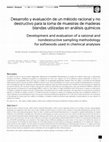
Madera y Bosques, 2017
La madera ha sido un recurso natural ampliamente utilizado por la humanidad. Particularmente, la ... more La madera ha sido un recurso natural ampliamente utilizado por la humanidad. Particularmente, la madera de coníferas destaca por su importancia ecológica, económica y distribución geográfica en comparación con otros taxa. Algunos usos de las diferentes especies maderables se basan en la evaluación de sus propiedades físicas, así como en el análisis de sus principales propiedades químicas. Para esto último, es deseable una metodología óptima para la toma de muestra de madera (TMM) en árboles en pie. Estas metodologías son escasas y pocas consideran anticipadamente en conjunto, tanto la cantidad necesaria de madera para las determinaciones químicas (toma de muestra racional) como también una toma de muestra no destructiva (sin talar los árboles). Por esta razón el objetivo del presente estudio fue desarrollar una metodología paso a paso que describa la TMM de coníferas de forma racional y no destructiva. La metodología TMM se evaluó en Abies religiosa a lo largo de diferentes sitios d...

Madera y Bosques, 2017
To understand the dynamics of land cover at the Parque Nacional Cofre de Perote, the rates of cha... more To understand the dynamics of land cover at the Parque Nacional Cofre de Perote, the rates of change in land use were compared at two different scales during the period 1995-2004. At the meso scale, these patterns were studied throughout the entire Parque Nacional Cofre de Perote, which is one of the 60 priority mountains of Mexico, and an important natural protected area of the country located in the state of Veracruz. At a micro scale, the work was focused in ejido El Conejo, located within the boundaries of this national park. Federal government digital orthophotos were used to determine changes in nine categories of land use. In both, the meso- and micro-scale, it was found that the predominant land cover categories are agriculture and forest. The probabilities of land cover change at both scales are low and essentially the same for most land use categories, reflecting both small gains in forest cover park-wide as well as the effectiveness of the ejido in managing natural resour...

Sociedad y Ambiente, 2018
Uno de los modelos para enfrentar la crisis socioambiental a nivel regional es la creación de emp... more Uno de los modelos para enfrentar la crisis socioambiental a nivel regional es la creación de empresas sociales. Sin embargo, es necesario la generación de indicadores para su evaluación, fortalecimiento o consolidación. El objetivo de este trabajo es evaluar, en un periodo acotado, y comparar, a partir de indicadores de sustentabilidad, tres empresas sociales en la región de los Tuxtlas, Veracruz, México. Se aplicaron entrevistas en profundidad a actores sociales clave de las empresas sociales y la información fue sometida al análisis de contenido para posteriormente aplicar los indicadores de sustentabilidad. La empresa social (ES) “Agua y Monte de Pajapan S. C. de C. V. de R. L.” es la que mejor resultados obtuvo: tres indicadores de sustentabilidad se mantuvieron y el resto creció; en la ES “Uno Caña Artesanías de Bambú Sociedad Cooperativa Tantoyuca en Acción S. C. de R. L. de C. V.” dos indicadores se mantuvieron, dos crecieron y dos bajaron; la ES “Naturaleza y Cultura Jomxuk...

Small-scale Forestry, 2017
In Mexico, a good number of national parks are home to local communities. It is therefore necessa... more In Mexico, a good number of national parks are home to local communities. It is therefore necessary to make forest conservation compatible with productive activities. Here we have evaluated the productive process of a group of women crafters and its ecological impact at the Cofre de Perote National Park (Veracruz, Mexico) where handicrafts are made with Pinus montezumae needles. The questions explored are: (1) What is the population structure of P. montezumae? (2) Is the production of handicrafts sustainable in terms of the natural productivity of needles? (3) Is the sale of handicrafts a competitive economic option compared to other productive activities in the region? (4) How much carbon is stored in the handicrafts, and to what extent is the intensity of forest fires reduced by the reduction of fuel? The height of P. montezumae individuals and their diameter at breast height were measured in randomly distributed plots of 10 9 10 m, and the production of needles recorded monthly for one year. The carbon content in the needles and trees was calculated through equations corresponding to the genus Pinus. It was concluded that the production of handicrafts is sustained by the natural production of pine needles (13,570.73 kg ha-1 per year), and that the economic income compares favorably to the one obtained from other economic activities in the region. On the other hand, the use of needles for handicrafts represented a reduction of 0.15% of the total fuel production in one year and contributed to the storage of 10.91 kg of C per year. The expansion of this productive activity through the participation of more women would significantly increase fuel reduction and
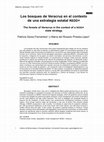
Madera y Bosques, 2016
Los bosques han sido reconocidos como pieza fundamental para mitigar uno de los impactos que más ... more Los bosques han sido reconocidos como pieza fundamental para mitigar uno de los impactos que más afectan la vida sobre el planeta: el calentamiento global. El conocimiento generado en las últimas décadas sobre los procesos ecosistémicos y los servicios que estos brindan para el bienestar humano así lo confirman. Dentro de las estrategias nacionales y regionales REDD+, enfocadas hacia la reducción y mitigación de los gases con efecto invernadero, las opciones más efectivas y económicas incluyen mejorar el manejo forestal y la conservación de bosques. Estas opciones, además, contribuyen a mejorar las condiciones de vida de los poseedores de bosques y al desarrollo sustentable de las regiones forestales, frecuentemente en zonas marginadas. Si bien Veracruz ha elaborado una Ley y un Plan Veracruzano de Acción Frente al Cambio Climático, la perspectiva REDD+ es novedosa y constituye una oportunidad para impulsar acciones de colaboración académica e interinstitucional con los tres niveles...
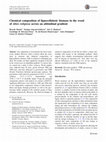
Journal of Wood Science, 2016
Tree adaptation to environment has been extensively studied. However, little is known about the v... more Tree adaptation to environment has been extensively studied. However, little is known about the variations in structure and chemical composition of lignocellulosic biomass (LB) in relation to altitudinal gradient. We wonder, are there significant variations in the LB in the wood across an altitudinal gradient? To answer this, we carried out a study of Abies religiosa. Wood samples were collected from 36 trees, grown between 3000 and 3500 masl, and then subjected to gravimetric and FTIR (Fourier Transform Infrared) spectroscopic analyses. The gravimetric results showed a proportion of 54.81 ± 2.20 % cellulose, 12.37 ± 1.33 % hemicellulose and 24.68 ± 1.16 % of insoluble lignin. Using the principal components analysis with analysis of variance (ANOVA), significant differences were found at 3100 and 3200 masl in two independent components related to both hemicellulose and lignin, through gravimetry as well as the spectroscopic bands assigned to the carbonyl groups of these polymers, respectively. However, the observed changes in chemical composition of LB did not follow a linear relationship with respect to the altitudinal gradient, which suggests that complex environmental interactions could also be playing an important role. Also, there were significant differences (p \ 0.05) in two of the empirical indexes calculated from the FTIR analysis.

Botanical Sciences, 2014
El conocimiento de la estructura y dinámica de la vegetación como estimadores del desempeño de la... more El conocimiento de la estructura y dinámica de la vegetación como estimadores del desempeño de las plantaciones forestales y de la regeneración natural en la rehabilitación es escaso, y tampoco se conoce el efecto de la ganadería extensiva sobre ambas. El objetivo de este estudio fue comparar el número de individuos por hectárea y la tasa anual de crecimiento entre las comunidades de pinos ( Pinus patula , P. montezumae y P. teocote ) procedentes de las plantaciones forestales y de la regeneración natural en sitios con dos diferentes condiciones (con y sin exclusión de ganado). Se encontraron diferencias significativas (P < 0.0001) en la tasa anual de crecimiento de la altura, en el diámetro basal del tallo y en el diámetro promedio de cobertura entre las plantaciones vs . la regeneración natural y entre las dos condiciones de exclusión de ganado. El número de individuos establecidos por hectárea fue significativamente mayor en la regeneración natural con exclusión de ganado (1,3...

Open Journal of Forestry, 2014
Propagation of native species in local nurseries is an important activity in reforestation and fo... more Propagation of native species in local nurseries is an important activity in reforestation and forest restoration programs. A requisite for successful plantation is that nursery produced plants are of a size and quality that allows optimal establishment under field conditions. Manipulation of edaphic processes through the combined use of the earthworm Pontoscolex corethrurus, Mucuna pruriens and inorganic fertilizers may promote faster biomass gain. This study assessed the activity of P. corethrurus, its association with M. pruriens (green manure) and inorganic fertilizers, on the growth of Quercus insignis seedlings under greenhouse conditions. Measured variables were basal diameter, height, biomass and foliar nitrogen content. Growth rates of basal diameter (F = 5.33; P < 0.0001) and height (F = 2.84; P < 0.0087) were significantly greater in the treatment of P. corethrurus-M. pruriens-inorganic fertilizer, relative to the control. Also, leaf biomass and total biomass of the seedlings were greater in the treatment of P. corethrurus-fertilizer (F = 2.32; P < 0.0290, F = 3.71; P < 0.0011, respectively) compared to the control treatment. Foliar nitrogen content was significantly higher (F = 2.54; P < 0.01742) in the treatment of P. corethrurus-inorganic fertilizer. Incorporating biological soil management techniques in propagation of native species is a good choice to assist reforestation and forest restoration.

The Open Forest Science Journal, 2011
The role played by nurse plants represents a common ecological process in nature; this being an i... more The role played by nurse plants represents a common ecological process in nature; this being an interaction where a particular species benefits from the presence of another species. Nurse plant species offer an efficient aid for the survival and growth of other species, including some which are of economic importance or interest for conservation. Baccharis conferta Kunth (shrub) and Abies religiosa (tree) are two common species which cohabit in the mountains of Mexico. It is general a practice, when establishing plantations to clear the mountainside, which involves cutting down and removing all shrubs. In order to discover whether B. conferta acts as a nurse plant when Abies religiosa seedlings are becoming established, this research evaluated the effect of this plant on the survival and growth of Abies religiosa seedlings. After taking records for two years, we found that the survival of A. religiosa did not vary significantly under the two contrasting conditions (65% with B. conferta and 55 % without B. conferta, nor was there significant interaction among years, contrasting conditions and experimental plots (G 2 = 0.01, P> 0.91). However, height and coverage were significantly greater under the B. conferta canopy ((t = 3614, P < 0.001 and t = 2910, P < 0.001, respectively) than without B. conferta, but not in terms of the stem base diameter (t = 0.689, P > 0.49). We concluded that B. conferta promotes the seedling growth of A. religiosa, reducing costs for commercial plantations or plantations aimed towards restoration.

Revista Chapingo Serie Ciencias Forestales y del Ambiente, 2014
RESUMEN L a tasa de crecimiento micelial de los hongos ectomicorrícicos Suillus granulatus y S. b... more RESUMEN L a tasa de crecimiento micelial de los hongos ectomicorrícicos Suillus granulatus y S. brevipes, se evaluó en tres medios de cultivo (PDA, BAF y MNM) con dos valores de pH (4.8 y 5.8), con el fin de seleccionar el mejor medio de cultivo. Las cepas se aislaron de esporomas colectados en el bosque de Pinus hartwegii del Parque Nacional Cofre de Perote, Veracruz, México. Se encontraron diferencias significativas (Tukey, P ≤ 0.05) en el área de crecimiento de ambas especies; los valores más altos se registraron en el medio PDA. Respecto a los valores de pH evaluados, no hubo diferencias significativas. Cada uno de los medios evaluados se puede utilizar para el cultivo de las cepas S. granulatus y S. brevipes dependiendo de los objetivos. El medio PDA fue el mejor sustrato para el crecimiento de las cepas. Se sugiere utilizar el medio BAF para la producción masiva de micelio para inóculo y el medio MNM se recomienda ya sea para el mantenimiento de las cepas o para pruebas de micorrización.
Open Journal of Forestry, 2014
A study was conducted on the forest structure of Pinus hartwegii Lindl., located at the Cofre de ... more A study was conducted on the forest structure of Pinus hartwegii Lindl., located at the Cofre de Perote National Park. The density, diameter, height and wooded coverage were evaluated along an altitudinal gradient from 3500 to 4000 meters in 20 plots of 100 m 2. The structure of the population was found to be in the form of an "inverted J". No statistically significant differences were found for any of the above-mentioned variables evaluated in the altitudinal range. A high density of suppressed individuals was found to occur at 50% of the sites sampled. Given the suppression characteristics of the trees, shelterwood is suggested for a better development of the woodland mass, as well as the introduction of mycorrhizal plants.

mammalia, 2014
Anairetes alpinus is currently categorized as an endangered species due to range fragmentation an... more Anairetes alpinus is currently categorized as an endangered species due to range fragmentation and habitat loss across its geographic distribution. Its range is only partially known, and potential effects of future climate change on its distribution have yet to be assessed. Using ecological niche models and future climates information, we assessed the geographic and environmental potential distribution of A. alpinus for the years 2050 and 2070, analyzing effects of habitat loss and the importance of existing protected areas (PAs) across the species' range. Our ecological niche models predicted a distributional range of ~ 59,000 to ~ 64,400 km 2 for the species, extending from northern Peru to northern Bolivia. However, habitat loss led to an important reduction (> 57%) in the current potential suitable areas. On average, the climate change reduced the potential distributional areas by ~ 49% and ~ 61% for 2050 and 2070, respectively. Synergistic effects of climate change and habitat loss are predicted to pose an even greater risk, leading to a net reduction in future potential distributions of over 75%. We also observed a shift of ~ 230 m increase in elevation between the range under present conditions and scenarios for 2050 and 2070. Although PAs were more suitable climatically than surrounding areas, for future scenarios, we observed an important reduction (on average over 25%) of proportion of PAs within the estimated distributional areas, as well as a significant (P < 0.05) reduction in mean habitat suitability values within PAs. Our novel results offer a guide for future integrative studies focused on defining conservation units and ecological corridors across the distribution of many Andean species.
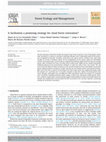
Forest Ecology and Management, 2014
The loss of primary cloud forest within the original range of this ecosystem is one of the highes... more The loss of primary cloud forest within the original range of this ecosystem is one of the highest worldwide. Facilitation is a process in the plant community dynamics that is potentially useful for the restoration of degraded ecosystems. Secondary cloud forest tree species possess attributes that make them suitable to be used as facilitator species for the establishment of tree species typical of intermediate and late successional stages. In this study we examined the facilitator potential of two early successional species, Alnus acuminata and Trema micrantha, both of which grow rapidly and are capable of gradually modifying physical micro-environmental conditions of open sites where forest was cleared. The aim was to assess the effects of these two species on the survival and growth of two intermediate successional species, Juglans pyriformis and Quercus insignis, and one late successional species, Oreomunnea mexicana. Open sites were used as control. Survivorship of the three target species was significantly higher under the canopies of A. acuminata and T. micrantha compared to open sites. Almost all annual growth rates (cover, diameter and height) were not different in both experiments (under the canopy of A. acuminata and T. micrantha), regarding treatment (under canopy vs. open areas) and species (target species). However, results for target species survival strongly suggest that plantations of early successional species can facilitate the establishment of intermediate and late successional trees, and thus represent a promising strategy for cloud forest restoration.
Forest Ecology and Management, 2004



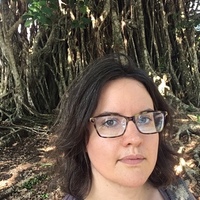

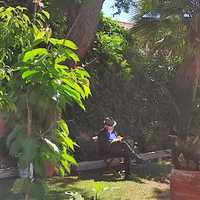





Uploads
Papers by Rosario Pineda Lopez
damental buscar técnicas apropiadas y apropiables que fortalezcan y estabilicen los sistemas productivos. Las técnicas agroforestales y de conservación de suelos son actividades que el Instituto Manantlán de Ecología y Conservación de la Biodiversidad (del Centro Universitario de la Costa Sur, Universidad de Guadalajara), la Dirección de la RBSM (de la SEMARNAP) y la participación activa de los productores del ejido de Zenzontla han estado desarrollando como una opción adaptativa para el manejo de la agricultura de ladera. Entre las opciones se encuentra el cultivo de pitayas (Stenocereus queretaroensis), cercos vivos y árboles frutales y forrajeros. Estamos también iniciando un proyecto de rehabilitación de bosques de mojotes (Brosimum allicastrum). El mojote es una especie dominante en cañadas, rodeadas por el bosque tropical caducifolio, llamado también selva baja o bosque tropical seco; el uso múltiple y su potencial ha sido probado en algunas regiones del país.
Como país, se debe considerar la solución de los siguientes factores de mayor impacto en el desarrollo de los procesos de investigación:
• El escaso acceso de la población a la educación superior, lo que limita la reproducción social de los investigadores.
• La escasa proporción del financiamiento nacional que se dedica a actividades de investigación y educación.
• La escasa participación e interacción entre el sector productivo y las universidades públicas.
En resumen, las universidades públicas han demostrado ser un camino viable para la generación de conocimientos y donde la investigación científica ha dado soporte a diferentes programas de conservación, manejo de recursos naturales, alimentos, salud pública, rehabilitación ecológica y prevención de desastres ecológicos, entre muchos otros. Con presupuestos suficientes, las universidades públicas pueden contribuir de manera significativa al desarrollo del país con equidad, justicia y responsabilidad ecológica.
Lázaro R. Sánchez-Velásquez María del Rosario Pineda-López José Luis Zúñiga-González
su gran biodiversidad, es y puede seguir siendo fuente potencial de recursos genéticos forestales para el país, debido a la gran cantidad de especies multiusos que habitan en el suelo veracruzano (Benítez Badillo et al., 2004). Por las características de la flora, la vegetación y su medio físico, Veracruz resguarda un enorme potencial para productos maderables y no maderables para el consumo nacio- nal y la exportación, por ejemplo: árboles de navi- dad, maderas preciosas, carbón, leña, forraje, comestibles, medicinales, cercos y productos indus- trializados, entre muchos otros (Benítez Badillo et al., 2004). El Pico de Orizaba, el Cofre de Perote y Huayacocotla, el sureste veracruzano, son las regio- nes más importantes del estado para la producción de madera (Sánchez-Velásquez et al., 1991; Ruelas Monjardín y Chávez Cortés, 1997). Afortunada- mente, aunque escasas, existen experiencias de manejo sustentable de los bosques por ejidatarios organizados en algunas áreas de montaña de Vera- cruz. Por ejemplo, la experiencia del Ingenio El Rosario, en el Cofre de Perote, podría usarse como punta de lanza para impulsar un manejo sustentable de los bosques de la región, donde existe una fuerte presión por la población aledaña. Recordemos que Veracruz es el estado con mayor población del país después del Estado de México y el Distrito Federal.
En el presente trabajo se hace un análisis del sec- tor forestal en Veracruz, se discuten los principales problemas, los logros, debilidades y se proponen, aunque en algunos aspectos no de manera original, sugerencias para el fortalecimiento del sector en el estado.